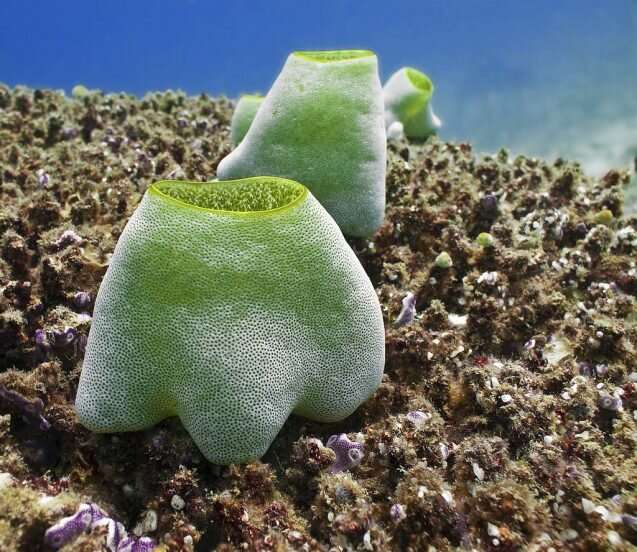A colorful sea squirt among coral in Egypt. Credit: Silke Baron/Wikimedia Commons
Antarctica may have a reputation for being cold, icy, and lifeless for miles on end, but an important marine animal near the continent is the focus of a new study. This study investigates how the animals—ascidians, also known as tunicates or sea squirts—react to shifts in marine ecosystems off the West Antarctic Peninsula, prompted by climate change.
Sea squirts live by filtering water in through their mouths, collecting nutrients from the water as it passes through their bodies, and then 'squirting' it out of their anuses. As tadpoles, sea squirts will swim around, eating food and growing and then searching for a suitable spot in which they can settle down, immobilized for the rest of their lives. Once they select a spot, sea squirts will attach themselves headfirst. They will then reabsorb some of their body parts and recycle them to create a new adult structure suited for the filtering process. Some will pick an isolated spot and live alone while others form whole colonies.
"Sea squirts are found in all the world's seas, at all depths," Gastón Alurralde, a researcher and marine ecologist at the National University of Cordoba in Argentina, who is not affiliated with the new study, explained in an interview with GlacierHub. He emphasized that sea squirts can exhibit strange body features, almost like alien species, in order to take advantage of the scarce resources at the ocean's lowest depths. "In many cases, they can even go unnoticed and we can step on them on rocky beaches," he stated, highlighting how these creatures exist almost everywhere.
As temperatures rise and glaciers melt, the water that they release carries sediment down into the ocean. This additional sediment can create problems for sea squirts. Speaking about his own research, Alurralde explained that his team found sea squirt populations would suffer as a result of increased sedimentation. Murkier waters make it more difficult for phytoplankton, sea squirts' main food source, to grow as they rely on light for energy. Sea squirts face a double threat then: their food supply is affected and their gills become clogged.
In the new study, researchers in South Korea measured the spatial patterns of sea squirt populations in Marian Cove, a fjord in the West Antarctic Peninsula with high levels of glacial melt. The team used a remotely operated vehicle to capture images and examine differences in the abundance of these organisms at various distances from the glacier. They found that ascidian populations were lowest in areas near the glaciers, and increased in number at greater distances.
The authors tracked not just numbers of individual ascidian organisms, but diversity of species as well. Closer to the glacier were early colonization communities in which only two species were dominant, while furthest from the glacier were more mature and varied communities. The study suggests that the increase in sediment from the melting glacier negatively affects sea squirts—it becomes more difficult for them to survive in areas that were previously habitable close to the glacier.
Alurralde emphasized, however, that climate change creates both problems and opportunities for these beings. "The loss of ice shelves in coastal areas has exposed large areas of the seabed that can be colonized by ascidians, where they can also take advantage of the increased phytoplankton production as a food source." In other words, while the increased sediment has pushed some sea squirts away from their old spots, others have colonized the previously ice-covered areas which are newly exposed as glaciers retreat. In this way, climate has both negative and positive effects on the populations of sea squirts in the West Antarctic Peninsula.
Alurralde added the intriguing suggestion that sea squirts may not just be affected by climate change, but might also impact climate change by sequestering carbon. "Antarctic ascidians are capable of forming 'animal forests' that can retain carbon in their tissues as they are presumed to be long-lived organisms. They form three-dimensional patches that can favor the retention of organic matter in the coastal areas of soft bottoms."
In other words, sea squirts are able to remove carbon that has been dissolved from the atmosphere into the ocean. Alurralde's use of the phrase "animal forests" brings trees to mind, drawing attention to the analogous roles that sea squirts and trees may play in sequestering carbon from the atmosphere. Many sea squirts form large colonies, and individuals in some species can live for up to 30 years. Their role in retaining and removing carbon may be significant, given their prevalence and long life span.
Furthermore, sea squirts play an important role "and are key organisms for the functioning of coastal ecosystems," Alurralde explained. "They participate in the cycling of nutrients, controlling primary production levels, transferring energy to various compartments of food webs, including humans, since they serve as food in many countries."
There is still much to learn about these fascinating creatures, especially in the face of a changing climate and melting glaciers in Antarctica. Sea squirts serve as a source of wonder and curiosity due to their ability to exist in seemingly lifeless areas, whether it be on the shores of the icy continent or at the lowest depths of the ocean floor. They also serve as an example that even creatures in distant places experience the effects of climate change, and that no place escapes the impacts of climate change.
More information: Dong-U Kim et al. Patterns, drivers and implications of ascidian distributions in a rapidly deglaciating fjord, King George Island, West Antarctic Peninsula, Ecological Indicators (2021). DOI: 10.1016/j.ecolind.2021.107467
Provided by Earth Institute at Columbia University
This story is republished courtesy of Earth Institute, Columbia University http://blogs.ei.columbia.edu.
























